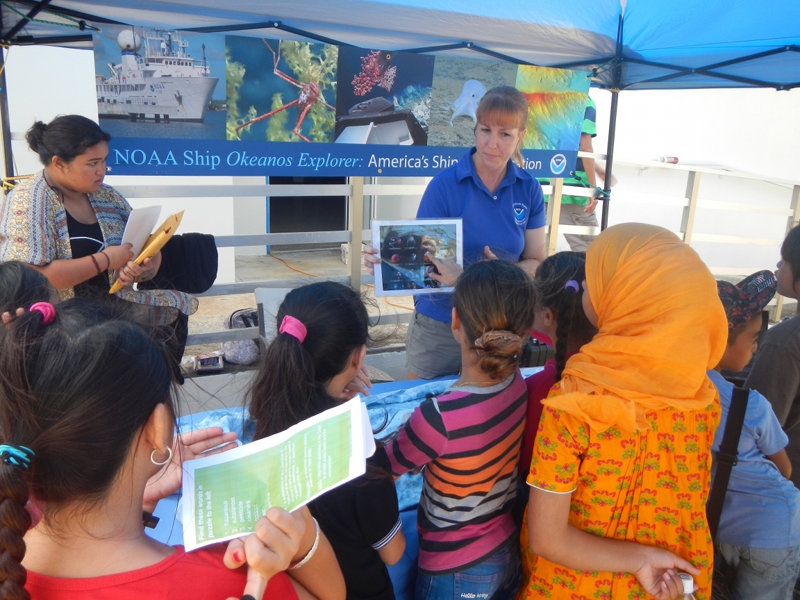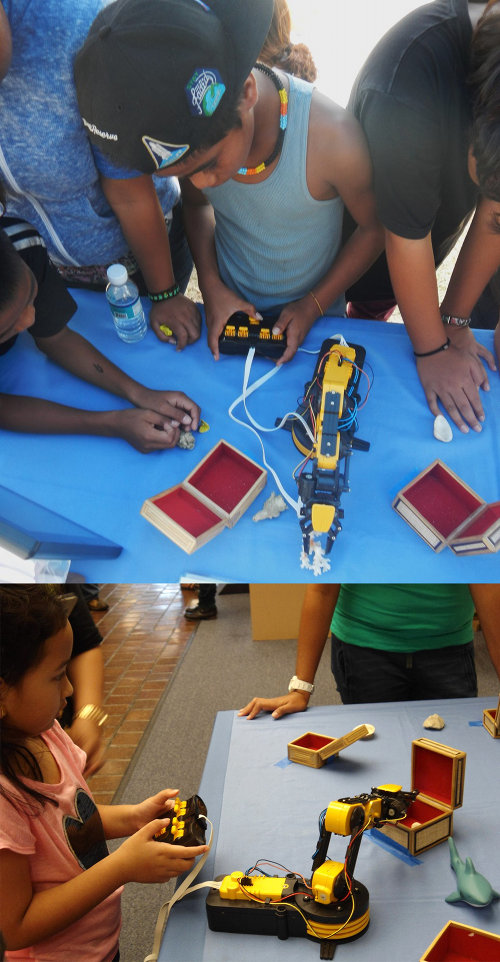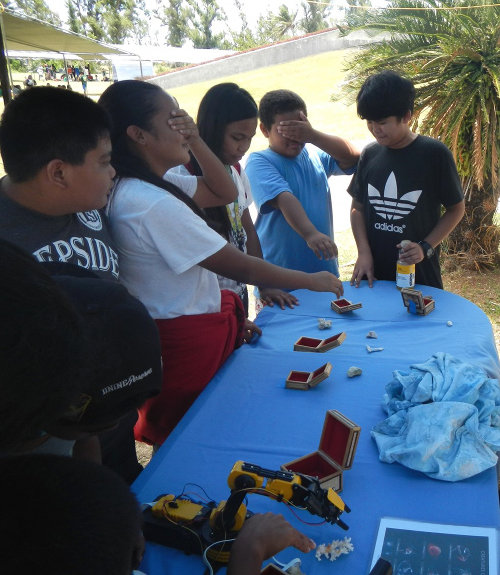
By Amy Vandehey - Outreach & Education Coordinator, NOAA Fisheries, Pacific Islands Regional Office
April 26, 2016

Students enjoyed seeing images of new species scientists have discovered on Okeanos expeditions. Image courtesy of NOAA Office of Ocean Exploration and Research, 2016 Deepwater Exploration of the Marianas. Download larger version (jpg, 5.7 MB).
A primary goal of NOAA's Office of Ocean Exploration and Research is to encourage the next generation of ocean explorers, scientists, and engineers. A variety of efforts are conducted by expedition teams and partners to encourage, inspire, and train the next generation. These efforts range from hosting presentations and workshops at local schools and community events to developing K-12 education curriculum, documenting and sharing the expedition online, and providing formal internship opportunities. Working in partnership with NOAA Fisheries, the 2016 Deepwater Exploration of the Marianas expedition has a particular emphasis on engaging the local community in Guam and Saipan – through public presentations, ship tours, live interactions with museums and schools, and partnerships. Some of these activities are conducted by the team onboard the ship and many more are conducted by the team on shore. All of these activities support overall NOAA and expedition objectives of engaging and inspiring the next generation.

Students loved to play the role of engineers and scientists by using a toy robotic arm to pick up rock samples and put them into boxes, simulating the actual ROV on the ship that collects geological specimens. Image courtesy of the NOAA Office of Ocean Exploration and Research, 2016 Deepwater Exploration of the Marianas. Download larger version (jpg, 962 KB).
I quizzed the group of fifth graders before me at the Saipan Environmental Expo in April 2016 on the characteristics of water as you travel deeper in the ocean, and I received some interesting answers:

Due to the limited time per group, students who didn’t use the robotic arm worked in pairs to collect their own samples, with the “chief scientists” giving directions to the ROV operators, who had their eyes covered and moved the “claw” only when directed to do so. Image courtesy of the NOAA Office of Ocean Exploration and Research, 2016 Deepwater Exploration of the Marianas. Download larger version (jpg, 646 KB).
As an educator, I try to quickly assess what my audience knows (or doesn’t know) about a topic, so that I can meet them at their level and make meaningful, personal connections. This approach usually involves trying to anticipate some of the common misconceptions people hold about various topics and addressing them directly.
How do you effectively communicate the scale of the Mariana Trench and the differences between shallow reef and deep-ocean communities to students who may not spend much of their free time in the water? How do you make someone care about nearby environments that seem as alien and foreign as the Moon?
In the 10–15 minutes that I am able to speak with each group of students, my goal is to impart the uniqueness of the work being done from NOAA Ship Okeanos Explorer and get the students excited about the exploration of the ocean — the last, mostly unknown frontier on Earth.
At the expo, it helped that many of the students were familiar with the movie Finding Nemo, which showed deep-sea species like anglerfish. They were amazed to hear that trash has been found on recent remotely operated vehicle (ROV) dives and that our everyday activities on land can affect the deep ocean.
At my table, I showed the students highlight videos from previous Okeanos Explorer cruises and pointed out several of the “new to us” species that scientists have found.
I traveled to Guam later in the week to speak with students in a high school biology class, who were still not “too cool” to test out the robotic arm. I heard exclamations such as:
On Earth Day at the Hagatña Library, children and adults alike enjoyed hearing about ocean exploration and came back to my table many times to perfect their skills with the robotic arm. Many visitors wanted to buy their own robot and were excited to follow along with the ROV dives online in their virtual backyard.
I hope that when these young students from Saipan and Guam choose a career in the future, some of them will say they chose a career in marine science because they were inspired by NOAA to keep their sense of wonder and to keep exploring.